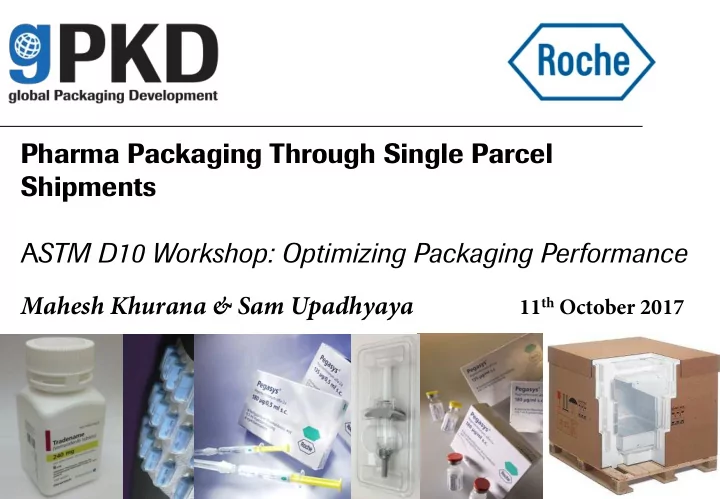

Pharma Packaging Through Single Parcel Shipments A STM D10 Workshop: Optimizing Packaging Performance Mahesh Khurana & Sam Upadhyaya 11 th October 2017
Content: • Project Goals • Planning Phase • Project Setup • Test Setup • e-value • Shipping Routes • Drop Results • Orientation Results 2
Project Goals: • Gather data for Roche temperature controlled single parcel shipments across the global distribution network: 1. Shocks and drops. 2. Package orientation during transit. 3
Planning Phase: • Planning phase included selection of: • Field data collection instrument • Representative shipping lanes • Test samples • Performing pilot shipments • Review published literature • Supply chain information included – dispatch volumes and sales volumes, size and weight ranges for single parcel shipments 4
5
Test setup • We used Lansmont SAVER devices to monitor the shock (3X90 and 3M30+) and the orientation of package (3D15). • Two representative packaging configurations representing high and low end of commercial shipments’ weight & dimensions were made. • Small Package: 14 x 10 x 10 in @ 11 lb (5kg) • Large Package: 24 x 24 x 20 in @ 40 lb (18kg) Large Small 6
e-value calculation • The coefficient of restitution ( e ) is the ratio of final velocity to initial velocity after an object undergoes a collision. Therefore it is possible to calculate the drop height of the package if e is known. • EDH is effective drop height, g is acceleration due to gravity, Δ V R is change in velocity. • We performed in-lab drop tests at 6 known heights , across multiple orientations with 3 repetitions each in order to reverse calculate e for our package configuration. • RESULTS: The e value for both package is calculated to be 0.6. 7
Shipping Routes • Shipping routes were selected in six countries within North America (N A), Europe (EU), Latin America (LATAM) and Asia. • Six round-trips shipments were done in each country. • Sending sites were Roche distribution center. • Receiving sites were selected based: • high dispatch volume, • mode of transport (air, truck, ferry), • geographical location within country • Shipments were done using the same method as for commercial Roche shipments – Courier service (like Fedex, DHL), dedicated truck etc. 8
9
Drop data results (drops >7in only) Drop Data Small Large Package Package Average number of drops for 6 3 one-way trip globally Max. drop height, in 54.6 48.2 Drop height at 99% occurrence 40.7 36.0 Drop height at 95% occurrence 24.3 28.5 Mean drop height, in 12.3 14.0 10
Drop data for Large and Small package 70 Avg. No. 60 of drops per one- 50 Number of Drops Small Mean way trip Large 12.3 6 3 40 Mean 14.3 30 95% Occurrence 24.3 20 95% Occurrence 10 28.5 Max Max 48.2 54.6 0 7 9 11 13 15 17 19 21 23 25 27 29 31 33 35 37 39 41 43 45 47 49 51 53 Drop Heights, inch
Top 5 drop heights Small Large Drop Data Package Package Highest drop, in 54.6 Asia Asia 48.2 2nd highest drop, in 48.0 Asia EU 39.6 3rd highest drop, in 42.4 Asia N A 33.7 4th highest drop, in 40.8 Asia NA 31.9 5th highest drop, in 40.7 Asia Asia 31.3 12
Drop Impact orientation results (drops >7in only) Impact Orientation Small Large Package Package 2 1 Face - Top 11 14 Face - Bottom 5 2 Face - Sides 9 9 Edge - Top 23 31 Edge - Bottom 9 11 Edge - Side 15 12 Corner - Top 26 20 Corner - Bottom 13
Conclusions from drop data • Majority of drops were bottom oriented for both packages (60% for small and 65% for large). • Average number of drops per one-way trip were 6 for small package and 3 for large package – (ASTM D7386 has 18 drops and D4169 has 12 drops). 14
15
Set-up: Orientation data for Large package • SAVER 3D15 was mounted on the Large package to record the orientation of package during the transit. • SAVER 3D15 include MEMS technology accelerometers with DC response measurement capability. 3D15 3X90 3M30+ 16
Orientation data for Large package ASIA LATAM N A EU Average Average one-way trip 71 141 85 60 89 duration (hours) 100 3 0 1 1 1 8 27 80 % Time on Orientation 50 60 Top 96 97 Side 40 71 Bottom 41 20 0 ASIA LATAM NA EU 17
Orientation detail: North America Bottom Side Top This graph shows the orientation as factor of time for North America. This graph displays the number of time the orientation changed and duration spent on certain orientation. Each color represents one round trip shipment.
Conclusions from orientation data • Orientation information is important to evaluate the performance of passive temperature controlled packages. – Examples: • Thermal packages may experience temperature excursions when orientation is changed. • Understand time to failure in different orientation and compare to normal shipping orientation (bottom). • 2-8°C is maintained only for 24 hours when package is oriented on side vs. 56 hours when oriented on bottom . 19
Doing now what patients need next
Recommend
More recommend